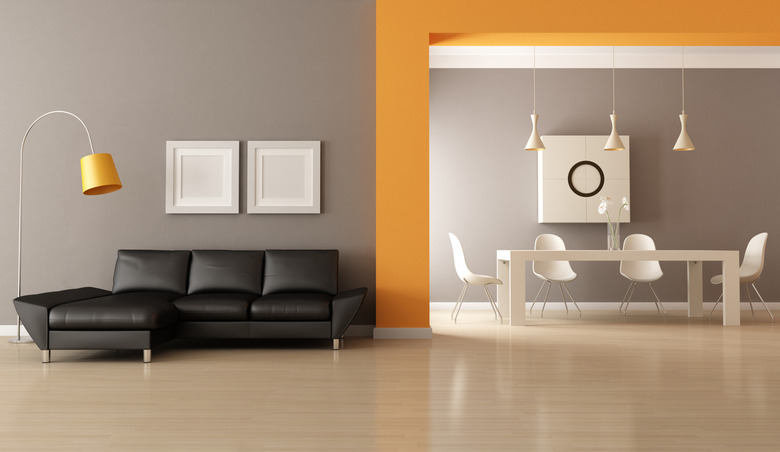How To Paint A Room With Two Different Colors
Paint a room in two distinct colors to disguise poor proportions or flaws, coordinate wall colors and furnishings or highlight architectural detail. In a room that lacks definition, a contrasting accent wall supplies focus. Two colors are lively in a room that threatens to come off as staid. A two-tone paint job can be as subtle as shades of gray or as vibrant as complements — such as teal paint on the patio-access wall of a pale apricot kitchen.
Accent Walls
Accent Walls
An accent wall is the perfect "frame" for a wall-hung art collection or a single, important piece. A fireplace wall painted to contrast with the other three walls in the room keeps the attention firmly on the hearth and makes it easy to arrange the conversation area. Accent walls provide contrast or a color link to the walls of an adjacent room, and with an accent wall you can add a strong hue that might overwhelm the space if the vibrant color covered the entire room. A cinnabar accent wall in the dining room holds the gilded pier glass or backs up the antique sideboard. In the nursery, the tangerine accent sounds a bright, childlike note in all-white decor punctuated by primary and secondary colored toys.
Chair Rails and Wainscoting
Chair Rails and Wainscoting
Your room is already divided in two horizontally by the chair rail, or the wainscoting panels on the lower half of the wall. Painting out the difference by using all one color looks odd, but highlighting the detail of the rail or the panels enriches the decor. Paint the upper wall lighter than the lower wall to "raise" the ceiling. Try glossy white enamel on all the trim, and flat lilac-pink on the walls above the chair rail. Paint the lower wall a deep plummy mauve to evoke a fin de siecle Paris salon or a romantic bedroom overlooking the Seine. Slick shiny white paint over the beadboard wainscoting at the beach house, and sponge or colorwash the upper walls soft cerulean or watery turquoise to evoke the sky or the sea.
Calculated Chevron
Calculated Chevron
Pattern the walls chevron instead of the sofa upholstery, and celebrate an exuberant room designed to hold the spare white Mid-Century Modern molded plastic furniture. Measure slanted angles meticulously, using a carpenter's level to ensure that zigzags travel on an even plane and that parallel lines are exact. Alternate the colors of zigzags — a subtle effect pairs tone-on-tone: dove-gray with medium-gray. A bold chevron juxtaposes contrasts — black and white, red and mint, grape and pumpkin. Cover a single wall in a chevron pattern and choose one of the paint colors for the remaining walls. Or paint a two-color chevron pattern over the entire room; keep the ceiling and trim white, and simplify the color scheme in the rest of the decor so the space doesn't feel claustrophobic or busy.
Free-Wheeling Freehand
Free-Wheeling Freehand
No chair rail? No problem. Use a carpenter's level, rollers and painter's tape to apply an unusual paint treatment that makes a virtue of the ragged and the unfinished. Paint the upper wall a light color — linen — that coordinates with a deeper hue — sapphire — to go on the lower wall. Measure a horizontal line around the room to mark the area for contrasting lower-wall paint, using a level and painter's tape. With a very small roller, paint a rough roller-width border around the room several shades deeper — putty — than the upper wall color. Then use a long-handled roller — the length makes it less stable and the paint will flow onto the wall less evenly — to cover the lower wall in sapphire. Move the roller horizontally and use the rough putty border as your guide. Leave traces of putty paint showing at the top edge of the sapphire lower wall.
